Page 1204 of 2896
EVAPORATIVE EMISSION SYSTEM
EC-35
C
D
E
F
G
H
I
J
K
L
MA
EC
Revision: June 20062007 Versa
EVAP SERVICE PORT
Positive pressure is delivered to the EVAP system through the EVAP
service port. If fuel vapor leakage in the EVAP system occurs, use a
leak detector to locate the leak.
Removal and InstallationUBS00QBA
EVAP CANISTER
Tighten EVAP canister as shown in the figure.
EVAP CANISTER VENT CONTROL VALVE
1. Turn EVAP canister vent control valve counterclockwise.
�Lock (A)
�Unlock (B)
2. Remove the EVAP canister vent control valve.
Always replace O-ring with a new one.
How to Detect Fuel Vapor LeakageUBS00QBB
CAUTION:
�Never use compressed air or a high pressure pump.
�Do not exceed 4.12 kPa (0.042 kg/cm2 , 0.6 psi) of pressure in EVAP system.
NOTE:
�Do not start engine.
�Improper installation of EVAP service port adapter to the EVAP service port may cause a leak.
SEF 4 62 UC
PBIB1214E
PBIB3091E
Page 1207 of 2896
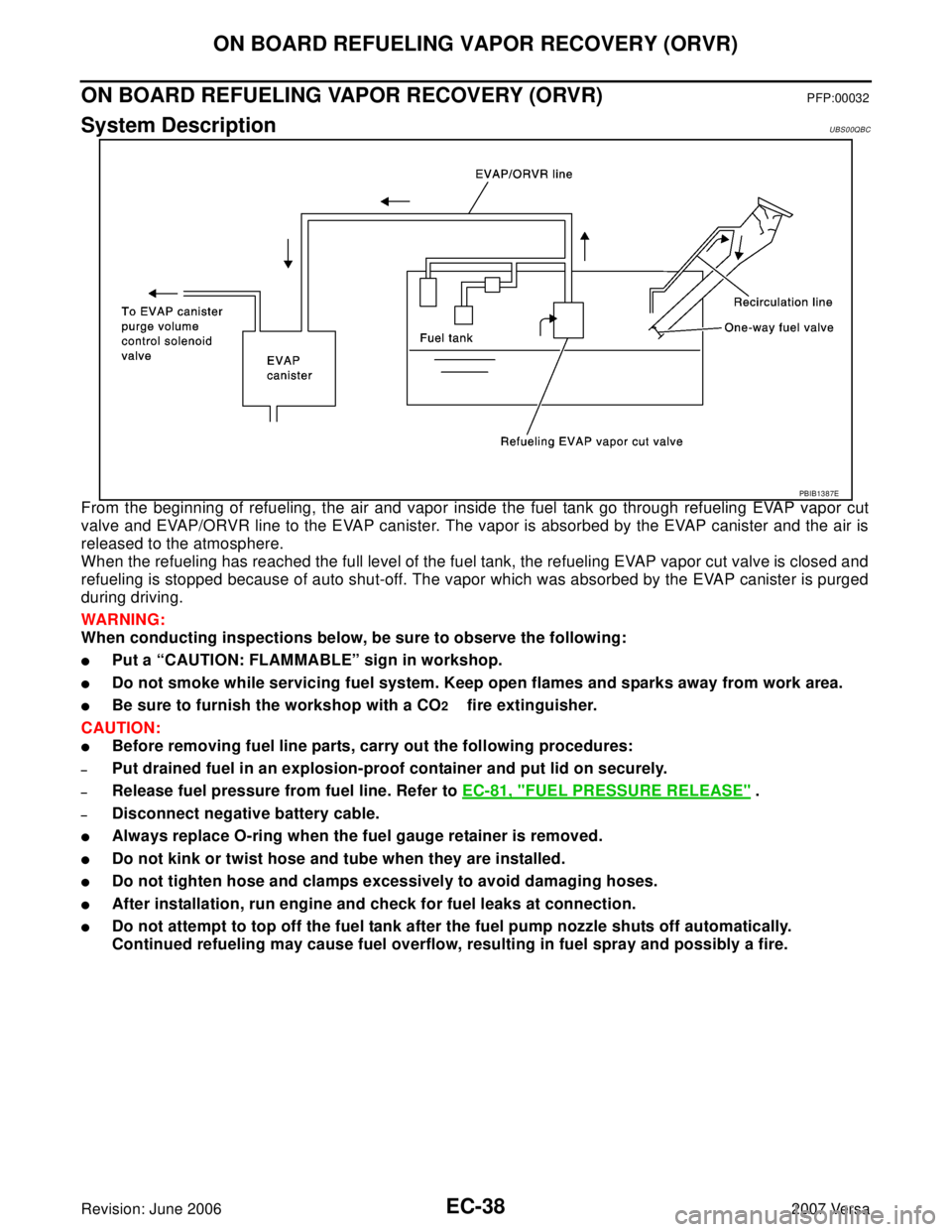
EC-38Revision: June 2006
ON BOARD REFUELING VAPOR RECOVERY (ORVR)
2007 Versa
ON BOARD REFUELING VAPOR RECOVERY (ORVR)PFP:00032
System DescriptionUBS00QBC
From the beginning of refueling, the air and vapor inside the fuel tank go through refueling EVAP vapor cut
valve and EVAP/ORVR line to the EVAP canister. The vapor is absorbed by the EVAP canister and the air is
released to the atmosphere.
When the refueling has reached the full level of the fuel tank, the refueling EVAP vapor cut valve is closed and
refueling is stopped because of auto shut-off. The vapor which was absorbed by the EVAP canister is purged
during driving.
WAR NIN G:
When conducting inspections below, be sure to observe the following:
�Put a “CAUTION: FLAMMABLE” sign in workshop.
�Do not smoke while servicing fuel system. Keep open flames and sparks away from work area.
�Be sure to furnish the workshop with a CO2 fire extinguisher.
CAUTION:
�Before removing fuel line parts, carry out the following procedures:
–Put drained fuel in an explosion-proof container and put lid on securely.
–Release fuel pressure from fuel line. Refer to EC-81, "FUEL PRESSURE RELEASE" .
–Disconnect negative battery cable.
�Always replace O-ring when the fuel gauge retainer is removed.
�Do not kink or twist hose and tube when they are installed.
�Do not tighten hose and clamps excessively to avoid damaging hoses.
�After installation, run engine and check for fuel leaks at connection.
�Do not attempt to top off the fuel tank after the fuel pump nozzle shuts off automatically.
Continued refueling may cause fuel overflow, resulting in fuel spray and possibly a fire.
PBIB1387E
Page 1208 of 2896
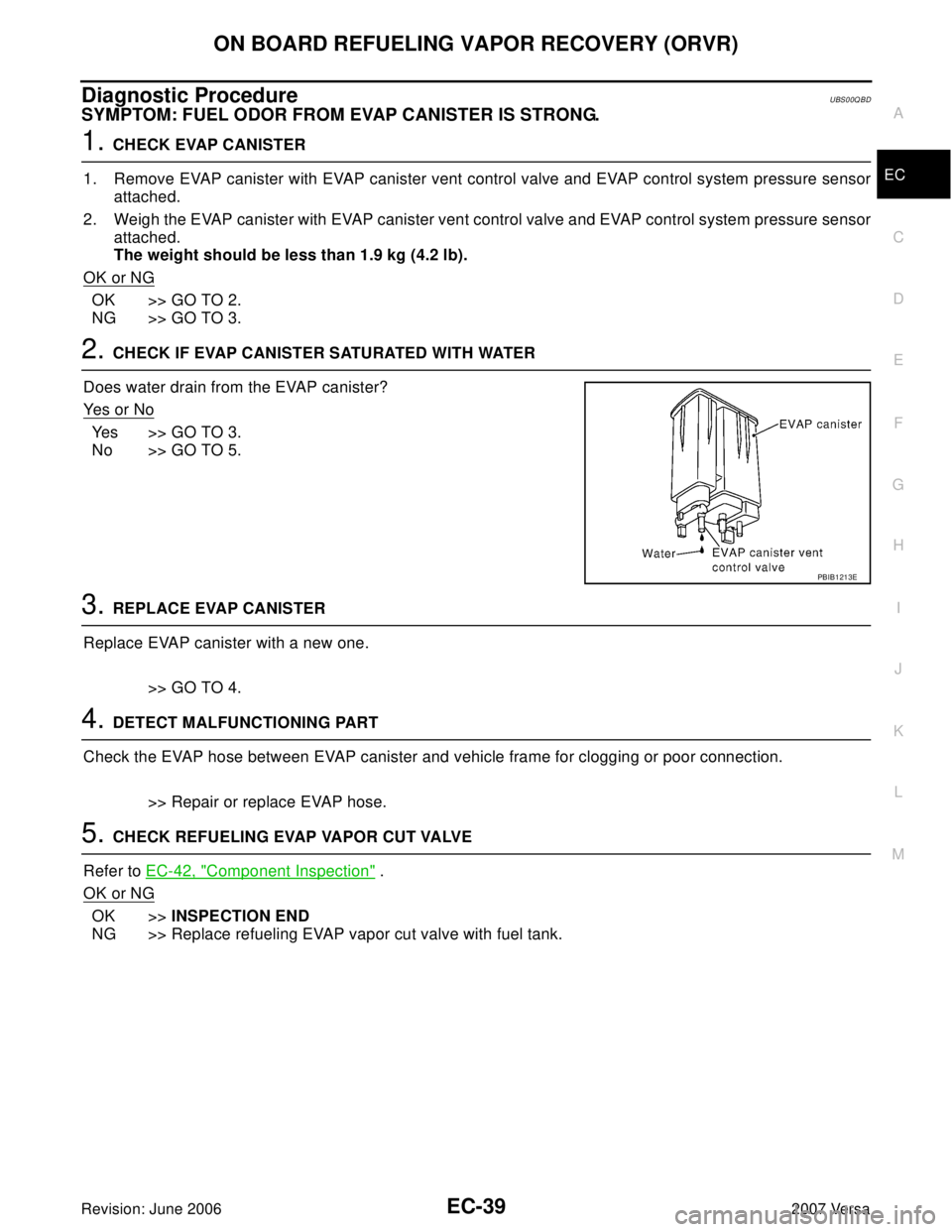
ON BOARD REFUELING VAPOR RECOVERY (ORVR)
EC-39
C
D
E
F
G
H
I
J
K
L
MA
EC
Revision: June 20062007 Versa
Diagnostic ProcedureUBS00QBD
SYMPTOM: FUEL ODOR FROM EVAP CANISTER IS STRONG.
1. CHECK EVAP CANISTER
1. Remove EVAP canister with EVAP canister vent control valve and EVAP control system pressure sensor
attached.
2. Weigh the EVAP canister with EVAP canister vent control valve and EVAP control system pressure sensor
attached.
The weight should be less than 1.9 kg (4.2 lb).
OK or NG
OK >> GO TO 2.
NG >> GO TO 3.
2. CHECK IF EVAP CANISTER SATURATED WITH WATER
Does water drain from the EVAP canister?
Ye s o r N o
Yes >> GO TO 3.
No >> GO TO 5.
3. REPLACE EVAP CANISTER
Replace EVAP canister with a new one.
>> GO TO 4.
4. DETECT MALFUNCTIONING PART
Check the EVAP hose between EVAP canister and vehicle frame for clogging or poor connection.
>> Repair or replace EVAP hose.
5. CHECK REFUELING EVAP VAPOR CUT VALVE
Refer to EC-42, "
Component Inspection" .
OK or NG
OK >>INSPECTION END
NG >> Replace refueling EVAP vapor cut valve with fuel tank.
PBIB1213E
Page 1209 of 2896
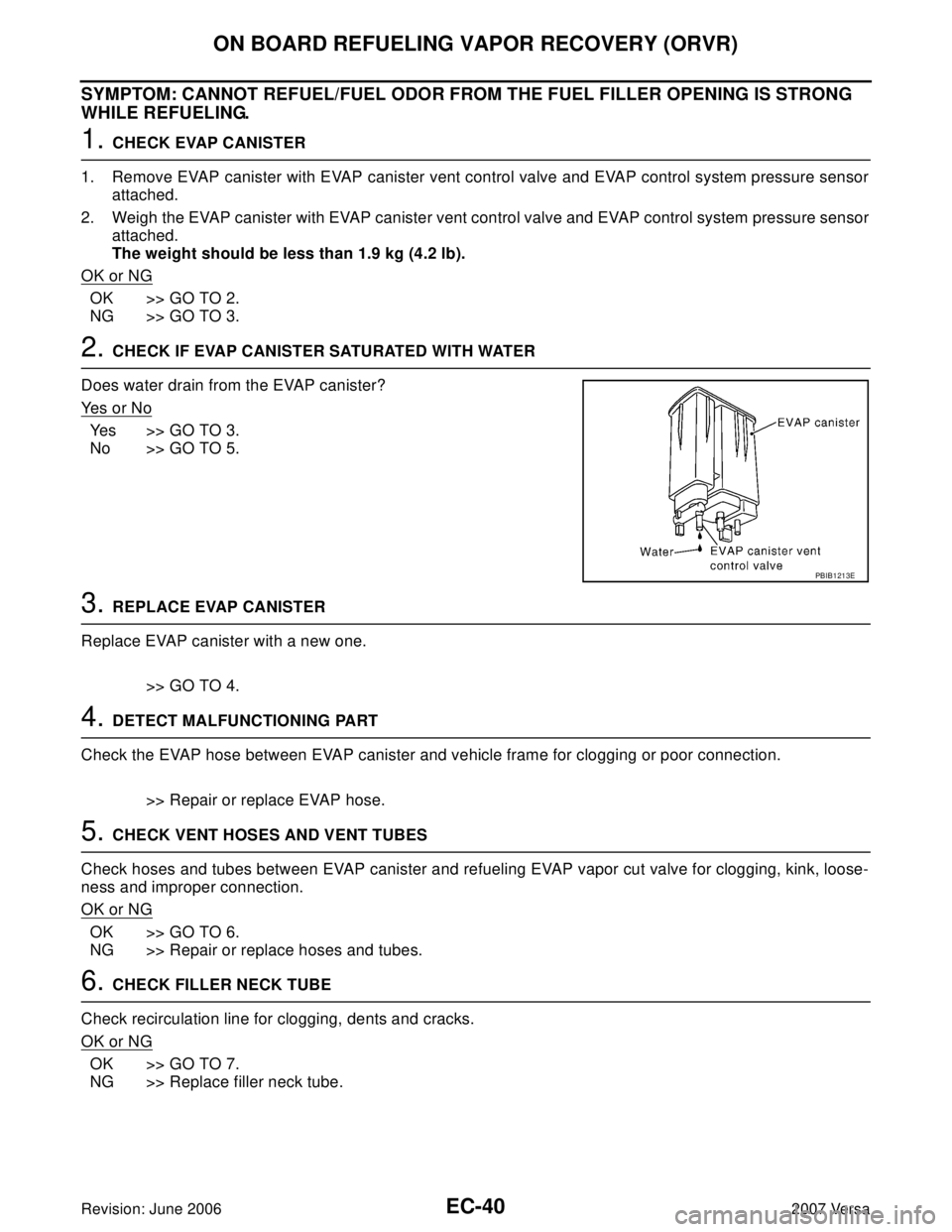
EC-40Revision: June 2006
ON BOARD REFUELING VAPOR RECOVERY (ORVR)
2007 Versa
SYMPTOM: CANNOT REFUEL/FUEL ODOR FROM THE FUEL FILLER OPENING IS STRONG
WHILE REFUELING.
1. CHECK EVAP CANISTER
1. Remove EVAP canister with EVAP canister vent control valve and EVAP control system pressure sensor
attached.
2. Weigh the EVAP canister with EVAP canister vent control valve and EVAP control system pressure sensor
attached.
The weight should be less than 1.9 kg (4.2 lb).
OK or NG
OK >> GO TO 2.
NG >> GO TO 3.
2. CHECK IF EVAP CANISTER SATURATED WITH WATER
Does water drain from the EVAP canister?
Ye s o r N o
Yes >> GO TO 3.
No >> GO TO 5.
3. REPLACE EVAP CANISTER
Replace EVAP canister with a new one.
>> GO TO 4.
4. DETECT MALFUNCTIONING PART
Check the EVAP hose between EVAP canister and vehicle frame for clogging or poor connection.
>> Repair or replace EVAP hose.
5. CHECK VENT HOSES AND VENT TUBES
Check hoses and tubes between EVAP canister and refueling EVAP vapor cut valve for clogging, kink, loose-
ness and improper connection.
OK or NG
OK >> GO TO 6.
NG >> Repair or replace hoses and tubes.
6. CHECK FILLER NECK TUBE
Check recirculation line for clogging, dents and cracks.
OK or NG
OK >> GO TO 7.
NG >> Replace filler neck tube.
PBIB1213E
Page 1210 of 2896
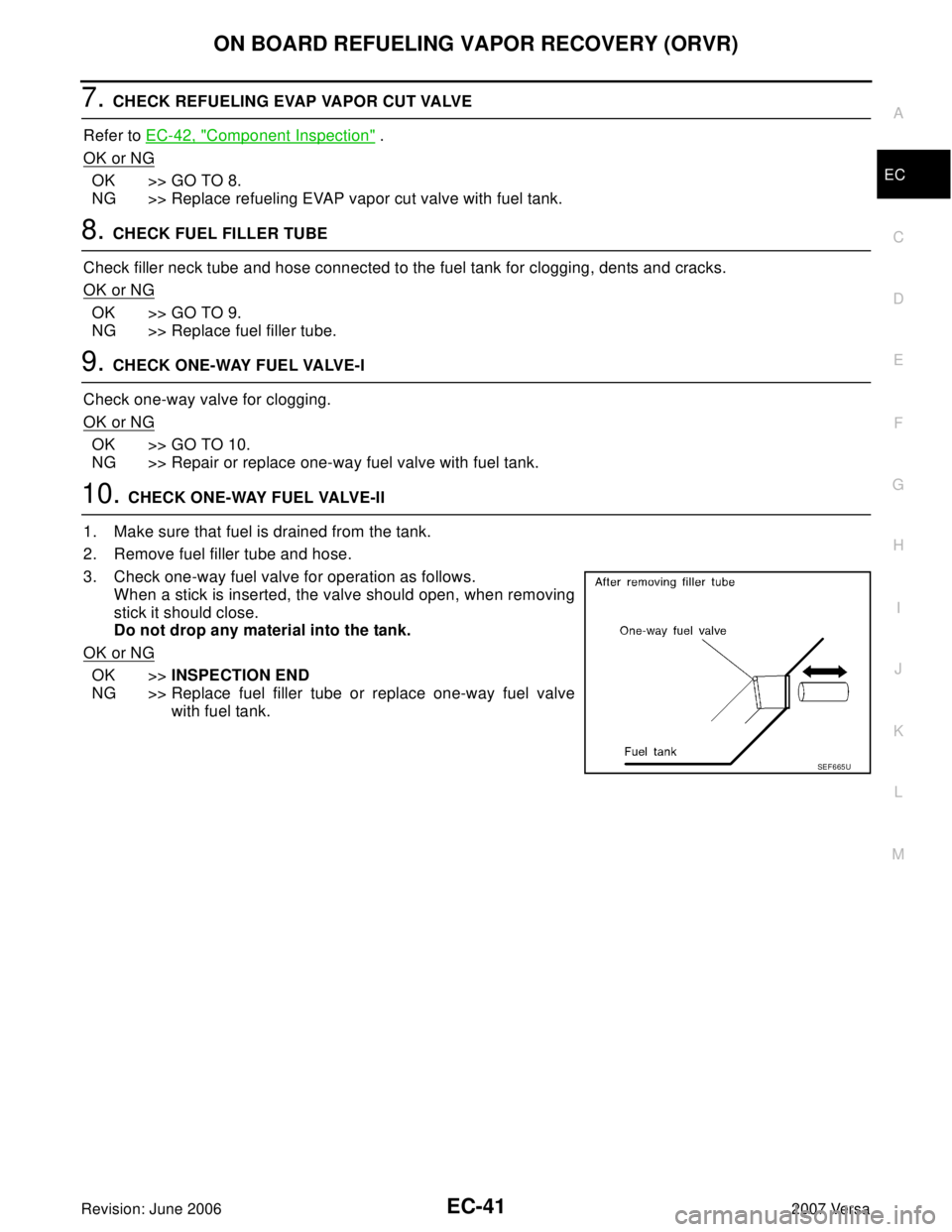
ON BOARD REFUELING VAPOR RECOVERY (ORVR)
EC-41
C
D
E
F
G
H
I
J
K
L
MA
EC
Revision: June 20062007 Versa
7. CHECK REFUELING EVAP VAPOR CUT VALVE
Refer to EC-42, "
Component Inspection" .
OK or NG
OK >> GO TO 8.
NG >> Replace refueling EVAP vapor cut valve with fuel tank.
8. CHECK FUEL FILLER TUBE
Check filler neck tube and hose connected to the fuel tank for clogging, dents and cracks.
OK or NG
OK >> GO TO 9.
NG >> Replace fuel filler tube.
9. CHECK ONE-WAY FUEL VALVE-I
Check one-way valve for clogging.
OK or NG
OK >> GO TO 10.
NG >> Repair or replace one-way fuel valve with fuel tank.
10. CHECK ONE-WAY FUEL VALVE-II
1. Make sure that fuel is drained from the tank.
2. Remove fuel filler tube and hose.
3. Check one-way fuel valve for operation as follows.
When a stick is inserted, the valve should open, when removing
stick it should close.
Do not drop any material into the tank.
OK or NG
OK >>INSPECTION END
NG >> Replace fuel filler tube or replace one-way fuel valve
with fuel tank.
SEF 6 65 U
Page 1211 of 2896
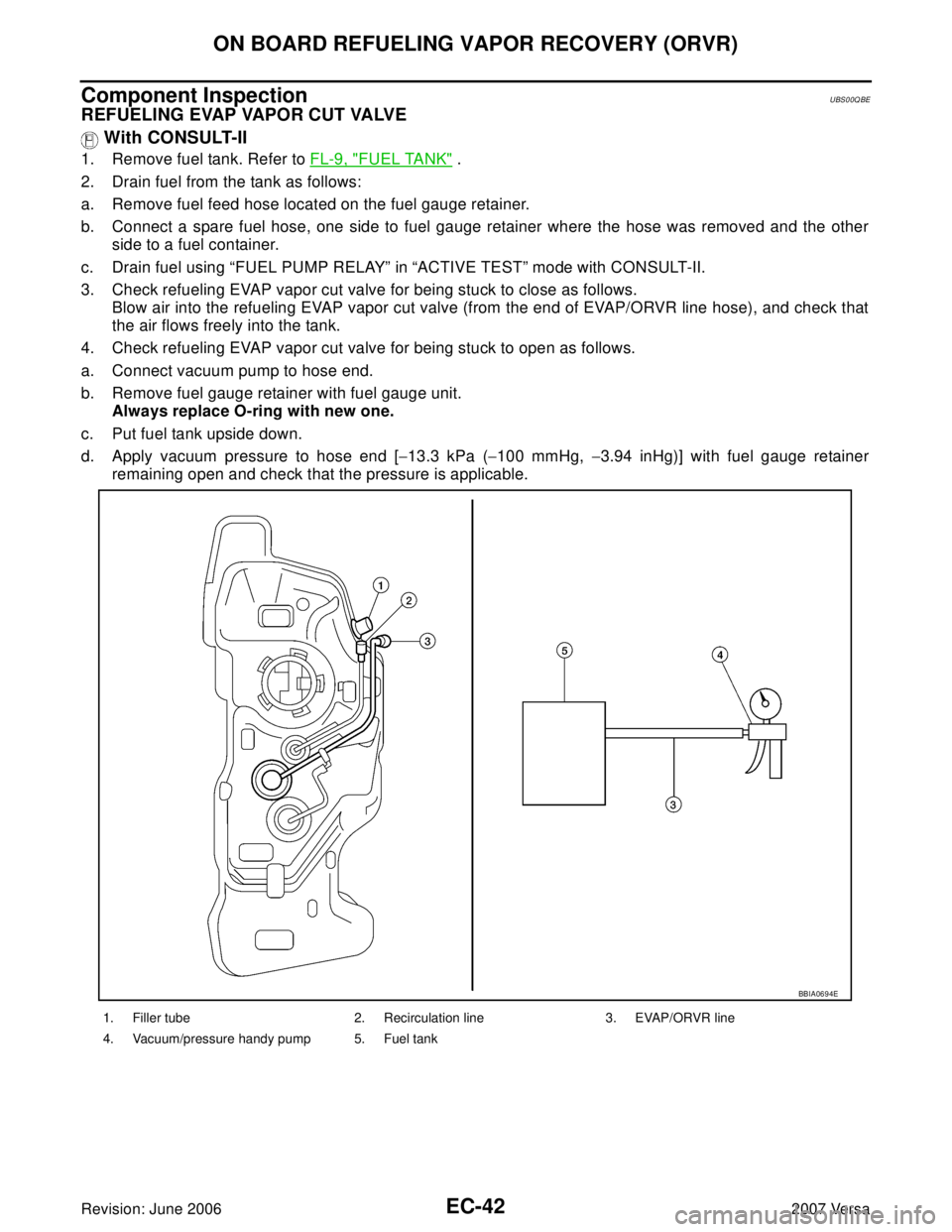
EC-42Revision: June 2006
ON BOARD REFUELING VAPOR RECOVERY (ORVR)
2007 Versa
Component InspectionUBS00QBE
REFUELING EVAP VAPOR CUT VALVE
With CONSULT-II
1. Remove fuel tank. Refer to FL-9, "FUEL TANK" .
2. Drain fuel from the tank as follows:
a. Remove fuel feed hose located on the fuel gauge retainer.
b. Connect a spare fuel hose, one side to fuel gauge retainer where the hose was removed and the other
side to a fuel container.
c. Drain fuel using “FUEL PUMP RELAY” in “ACTIVE TEST” mode with CONSULT-II.
3. Check refueling EVAP vapor cut valve for being stuck to close as follows.
Blow air into the refueling EVAP vapor cut valve (from the end of EVAP/ORVR line hose), and check that
the air flows freely into the tank.
4. Check refueling EVAP vapor cut valve for being stuck to open as follows.
a. Connect vacuum pump to hose end.
b. Remove fuel gauge retainer with fuel gauge unit.
Always replace O-ring with new one.
c. Put fuel tank upside down.
d. Apply vacuum pressure to hose end [−13.3 kPa (−100 mmHg, −3.94 inHg)] with fuel gauge retainer
remaining open and check that the pressure is applicable.
1. Filler tube 2. Recirculation line 3. EVAP/ORVR line
4. Vacuum/pressure handy pump 5. Fuel tank
BBIA0694E
Page 1212 of 2896
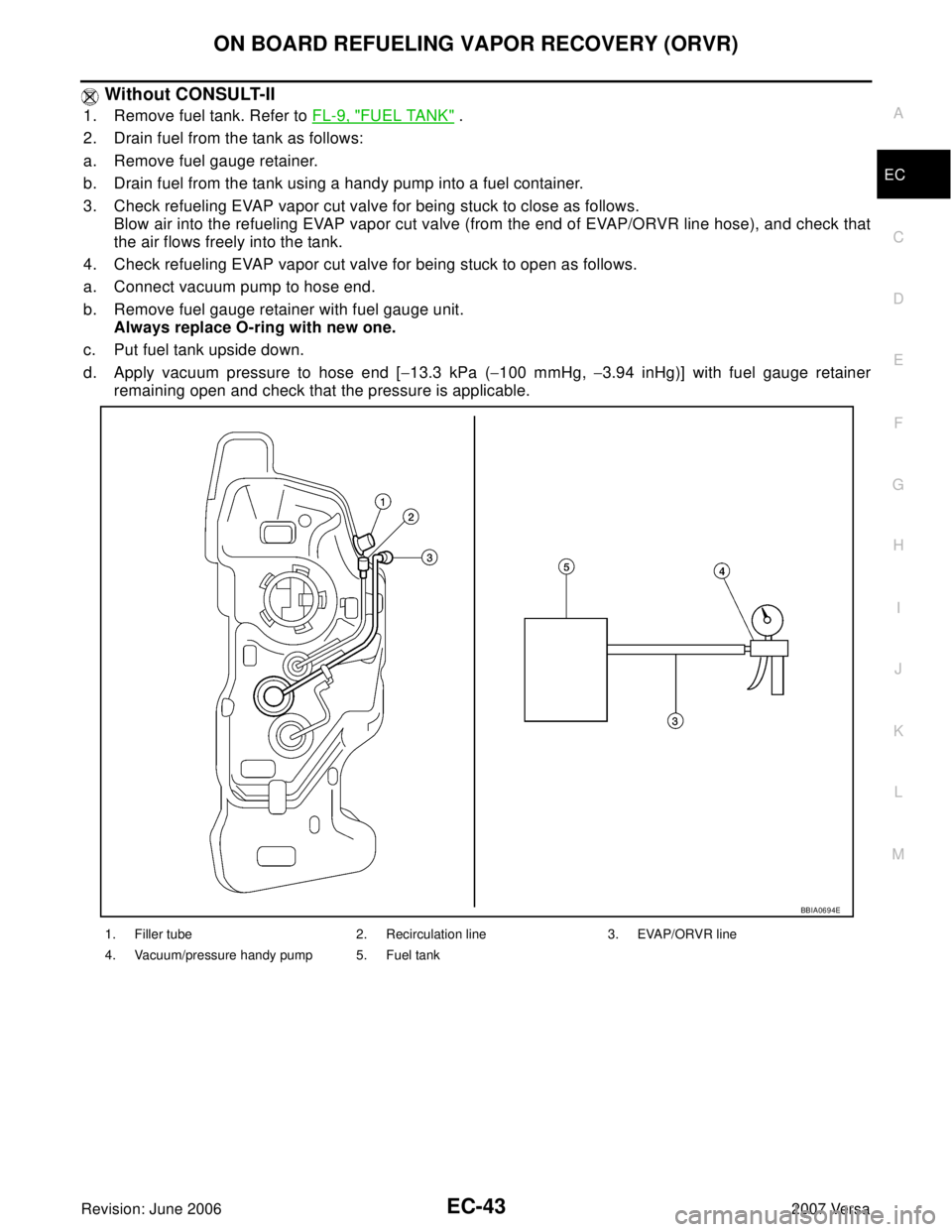
ON BOARD REFUELING VAPOR RECOVERY (ORVR)
EC-43
C
D
E
F
G
H
I
J
K
L
MA
EC
Revision: June 20062007 Versa
Without CONSULT-II
1. Remove fuel tank. Refer to FL-9, "FUEL TANK" .
2. Drain fuel from the tank as follows:
a. Remove fuel gauge retainer.
b. Drain fuel from the tank using a handy pump into a fuel container.
3. Check refueling EVAP vapor cut valve for being stuck to close as follows.
Blow air into the refueling EVAP vapor cut valve (from the end of EVAP/ORVR line hose), and check that
the air flows freely into the tank.
4. Check refueling EVAP vapor cut valve for being stuck to open as follows.
a. Connect vacuum pump to hose end.
b. Remove fuel gauge retainer with fuel gauge unit.
Always replace O-ring with new one.
c. Put fuel tank upside down.
d. Apply vacuum pressure to hose end [−13.3 kPa (−100 mmHg, −3.94 inHg)] with fuel gauge retainer
remaining open and check that the pressure is applicable.
1. Filler tube 2. Recirculation line 3. EVAP/ORVR line
4. Vacuum/pressure handy pump 5. Fuel tank
BBIA0694E
Page 1217 of 2896
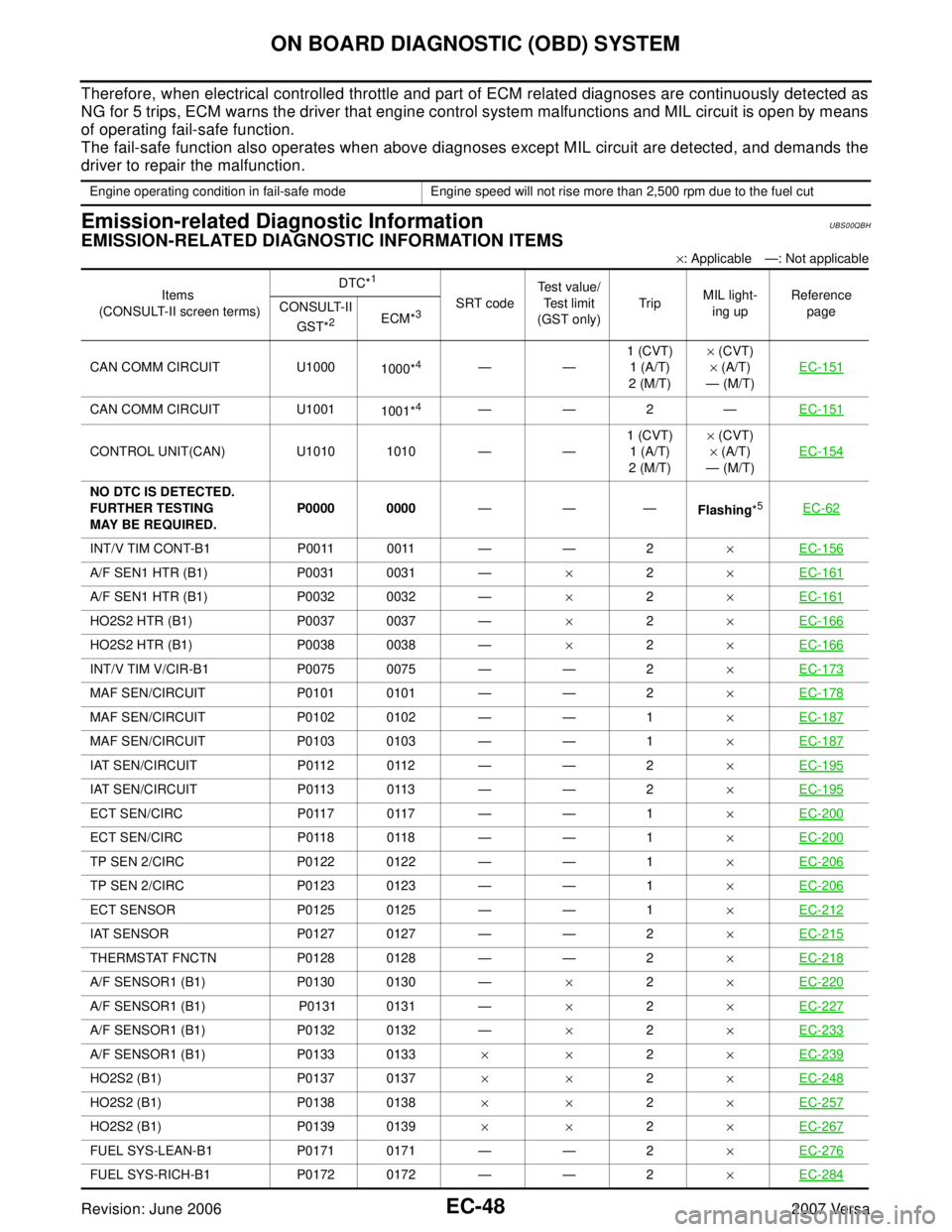
EC-48Revision: June 2006
ON BOARD DIAGNOSTIC (OBD) SYSTEM
2007 Versa
Therefore, when electrical controlled throttle and part of ECM related diagnoses are continuously detected as
NG for 5 trips, ECM warns the driver that engine control system malfunctions and MIL circuit is open by means
of operating fail-safe function.
The fail-safe function also operates when above diagnoses except MIL circuit are detected, and demands the
driver to repair the malfunction.
Emission-related Diagnostic InformationUBS00QBH
EMISSION-RELATED DIAGNOSTIC INFORMATION ITEMS
×: Applicable —: Not applicable Engine operating condition in fail-safe mode Engine speed will not rise more than 2,500 rpm due to the fuel cut
Items
(CONSULT-II screen terms)DTC*
1
SRT codeTe s t v a l u e /
Test limit
(GST only)TripMIL light-
ing upReference
page CONSULT-II
GST*
2ECM*3
CAN COMM CIRCUIT U1000
1000*4——1 (CVT)
1 (A/T)
2 (M/T)× (CVT)
× (A/T)
— (M/T)EC-151
CAN COMM CIRCUIT U1001
1001*4——2—EC-151
CONTROL UNIT(CAN) U1010 1010 — —1 (CVT)
1 (A/T)
2 (M/T)× (CVT)
× (A/T)
— (M/T)EC-154
NO DTC IS DETECTED.
FURTHER TESTING
MAY BE REQUIRED.P0000 0000———
Flashing*5EC-62
INT/V TIM CONT-B1 P0011 0011 — — 2×EC-156
A/F SEN1 HTR (B1) P0031 0031 —×2×EC-161
A/F SEN1 HTR (B1) P0032 0032 —×2×EC-161
HO2S2 HTR (B1) P0037 0037 —×2×EC-166
HO2S2 HTR (B1) P0038 0038 —×2×EC-166
INT/V TIM V/CIR-B1 P0075 0075 — — 2×EC-173
MAF SEN/CIRCUIT P0101 0101 — — 2×EC-178
MAF SEN/CIRCUIT P0102 0102 — — 1×EC-187
MAF SEN/CIRCUIT P0103 0103 — — 1×EC-187
IAT SEN/CIRCUIT P0112 0112 — — 2×EC-195
IAT SEN/CIRCUIT P0113 0113 — — 2×EC-195
ECT SEN/CIRC P0117 0117 — — 1×EC-200
ECT SEN/CIRC P0118 0118 — — 1×EC-200
TP SEN 2/CIRC P0122 0122 — — 1×EC-206
TP SEN 2/CIRC P0123 0123 — — 1×EC-206
ECT SENSOR P0125 0125 — — 1×EC-212
IAT SENSOR P0127 0127 — — 2×EC-215
THERMSTAT FNCTN P0128 0128 — — 2×EC-218
A/F SENSOR1 (B1) P0130 0130 —×2×EC-220
A/F SENSOR1 (B1) P0131 0131 —×2×EC-227
A/F SENSOR1 (B1) P0132 0132 —×2×EC-233
A/F SENSOR1 (B1) P0133 0133××2×EC-239
HO2S2 (B1) P0137 0137××2×EC-248
HO2S2 (B1) P0138 0138××2×EC-257
HO2S2 (B1) P0139 0139××2×EC-267
FUEL SYS-LEAN-B1 P0171 0171 — — 2×EC-276
FUEL SYS-RICH-B1 P0172 0172 — — 2×EC-284